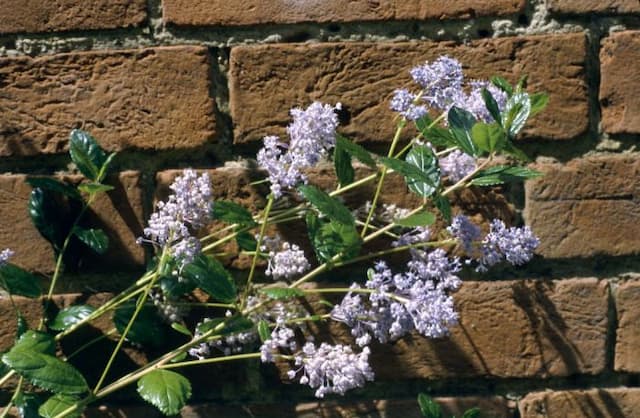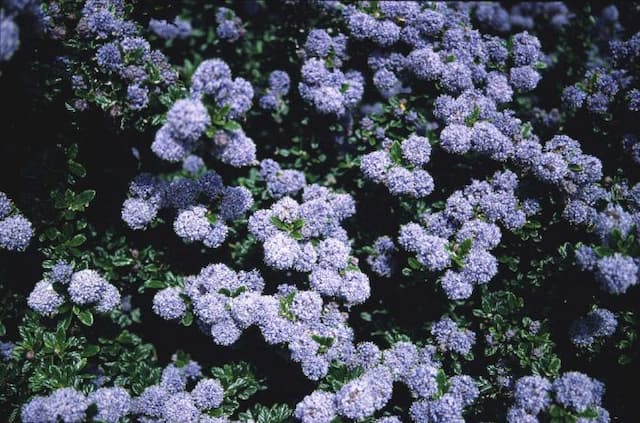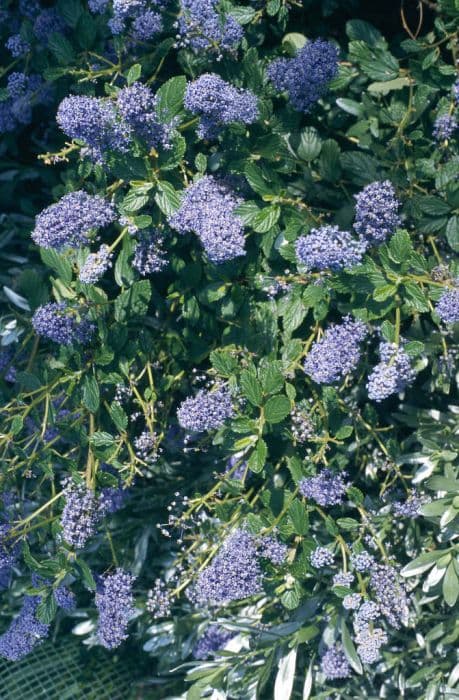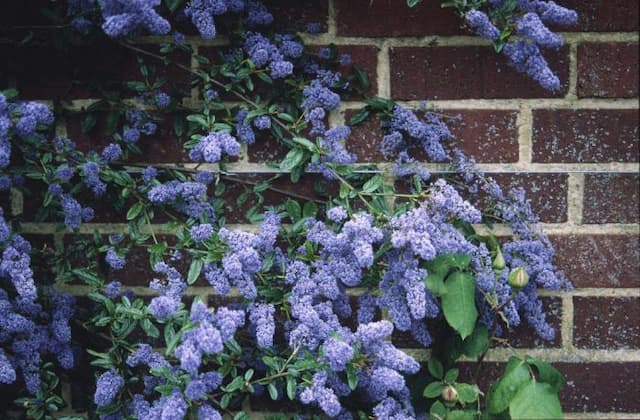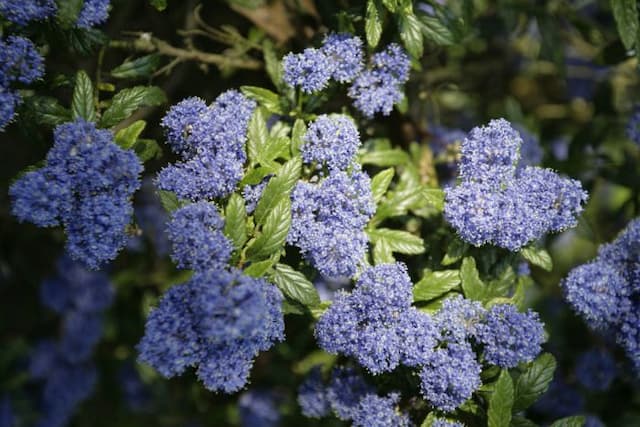California Lilac Ceanothus arboreus 'Trewithen Blue'

ABOUT
The Ceanothus arboreus 'Trewithen Blue', commonly known as the California lilac 'Trewithen Blue', is a striking plant with a profusion of deep blue flowers. These blossoms come together in dense, cone-shaped clusters that make a vivid display against the backdrop of the foliage. The leaves of the California lilac 'Trewithen Blue' are glossy green, and they have a finely textured, leathery feel to them, adding a layer of visual interest and contrast to the bright blooms. The overall appearance of this plant is lush and vibrant, with the flower clusters creating a showy spectacle that is typically seen in the spring and early summer. The growth habit of this California lilac presents an elegantly rounded shape with a dense, bushy appearance lending itself well to use as an ornamental feature in gardens and landscapes.
About this plant
 Names
NamesSynonyms
California Lilac, Blueblossom, Blue Bush, Wild Lilac
Common names
Ceanothus arboreus 'Trewithen Blue'.
 Toxicity
ToxicityTo humans
California lilac (Ceanothus arboreus 'Trewithen Blue') is not commonly known to be toxic to humans. There is limited information available about its toxicity, but it is generally not considered dangerous. Accidental ingestion of parts of this plant is unlikely to cause more than mild stomach upset, if any symptoms occur at all.
To pets
California lilac is also not widely recognized as a toxic plant to pets, including dogs and cats. Similar to its effects on humans, it is not believed to cause significant harm if ingested by pets. However, as with any non-food plant, consumption of large quantities may lead to gastrointestinal discomfort or other mild symptoms, so it is still advisable to prevent pets from eating the plant.
 Characteristics
CharacteristicsLife cycle
Perennials
Foliage type
Evergreen
Color of leaves
Green
Flower color
Blue
Height
10-20 feet (3-6 meters)
Spread
10-20 feet (3-6 meters)
Plant type
Shrub
Hardiness zones
8
Native area
California
Benefits
 General Benefits
General Benefits- Attracts Pollinators: Ceanothus arboreus 'Trewithen Blue', commonly known as California Lilac, attracts bees, butterflies, and other beneficial pollinators, enhancing biodiversity.
- Drought Tolerant: Once established, California Lilac is drought resistant, making it suitable for xeriscaping and water-conservation gardens.
- Low Maintenance: California Lilac typically requires minimal care once it is established, reducing the need for frequent watering, fertilizing, or pruning.
- Erosion Control: The plant’s root system helps stabilize slopes and hillsides, preventing soil erosion especially in drier climates.
- Ornamental Value: California Lilac offers lush green foliage and vibrant blue flowers, making it an attractive addition to landscapes.
- Habitat Providing: The shrub provides shelter and nesting sites for birds and other wildlife.
- Fast Growing: California Lilac has a rapid growth rate, which can quickly provide coverage or fill in landscaping areas.
- Privacy Screening: With its dense growth habit, it can be used as a natural privacy screen in gardens and yards.
- Versatile Landscaping: This plant is suitable for a range of landscaping applications, including as a hedge, background plant, or specimen plant.
- Native Appeal: It is native to California, making it an appropriate choice for gardens looking to incorporate native plant species.
 Medical Properties
Medical PropertiesThis plant is not used for medical purposes.
 Air-purifying Qualities
Air-purifying QualitiesThis plant is not specifically known for air purifying qualities.
 Other Uses
Other Uses- As a natural dye: The leaves of the California lilac can be used to produce a greenish dye, suitable for coloring textiles and crafting materials.
- Insect habitat: Its dense foliage can provide a living space or protective cover for beneficial insects, such as ladybugs and bees, which are important for garden health and pollination.
- Soil stabilization: The California lilac's extensive root system can be utilized to prevent soil erosion on slopes and banks, helping maintain landscape integrity.
- Creative arts: The vibrant blue flowers can be used in floral arrangements or as inspiration in painting and photography for their striking color.
- Outdoor furniture feature: Incorporating the California lilac into landscapes where outdoor seating is present can create a serene and fragrant environment for relaxation.
- Privacy screen: The plant can grow into a dense shrub, making it an effective natural screen to ensure privacy in residential gardens.
- Landscaping themes: It can be used to establish a Californian or Mediterranean theme in gardens worldwide due to its origin and growth habit.
- Educational tool: California lilac can be part of school or educational gardens, teaching students about native plants and their role in local ecosystems.
- Fragrance crafting: The natural scent of the California lilac can be captured and used to make perfumes or infused oils for aromatherapy purposes.
- Bonsai cultivation: For enthusiasts, the California lilac can be trained and grown as a bonsai, showcasing the plant's beauty on a miniature scale.
Interesting Facts
 Feng Shui
Feng ShuiThe California lilac is not used in Feng Shui practice.
 Zodiac Sign Compitability
Zodiac Sign CompitabilityThe California lilac is not used in astrology practice.
 Plant Symbolism
Plant Symbolism- Resilience: The Ceanothus arboreus 'Trewithen Blue', commonly known as the California Lilac, is known for its ability to thrive in dry conditions, symbolizing the ability to endure and persist through challenges.
- Hope: With its bright blue flowers, the California Lilac is often associated with hope and an optimistic outlook towards the future.
- Renewal: Blooming in the spring, the California Lilac represents new beginnings and the renewal of life.
- Beauty: The California Lilac is admired for its striking blue flowers, symbolizing natural beauty and grace in the plant world.
 Water
WaterThe California Lilac, commonly known as the Ceanothus arboreus 'Trewithen Blue', prefers moderate watering with a deep soaking method, allowing the soil to dry out between waterings to prevent root rot. In the growing season, water approximately once a week, providing about 1-2 gallons per plant depending on the size and soil conditions. During the dormant season, reduce the frequency to once every two to three weeks, with attention paid to rainfall, ensuring the plant does not sit in soggy soil. Always check the top few inches of the soil for dryness before adding water.
 Light
LightThe California Lilac thrives in full sun, requiring a minimum of six hours of direct light daily. Plant it in a spot where it can receive unobstructed sunlight for the best flowering and health. Avoid locations with filtered or partial shade, as too little light can lead to sparse blooms and a leggy growth habit.
 Temperature
TemperatureThe California Lilac is hardy and can tolerate a wide range of temperatures. It thrives in conditions between 50°F and 70°F but can withstand minimum temperatures down to around 10°F. The maximum temperature tolerated is close to 100°F, provided the plant receives adequate watering during periods of extreme heat.
 Pruning
PruningPruning the California Lilac is important to maintain shape and encourage new growth. Prune immediately after the blooming period, typically late spring or early summer. Remove any dead or diseased wood and cut back up to one-third of the oldest branches to invigorate the plant. Regular pruning also helps to prevent the center of the plant from becoming too dense, which can lead to issues with air circulation.
 Cleaning
CleaningAs needed
 Soil
SoilCalifornia Lilac (Ceanothus arboreus 'Trewithen Blue') prefers well-draining soil with a pH range of 5.5 to 7.5. A good soil mix can be created using equal parts of loamy soil, peat, or compost, and coarse sand or perlite to ensure proper drainage. Regularly check the soil pH and amend as necessary to maintain optimal growth conditions.
 Repotting
RepottingCalifornia Lilac does not typically require frequent repotting and can be repotted every 2 to 3 years or when the plant outgrows its current container. Ensure that the new pot has adequate drainage holes to prevent waterlogging.
 Humidity & Misting
Humidity & MistingCalifornia Lilac thrives in moderate humidity levels but is quite adaptable to lower humidity conditions, making it suitable for various outdoor environments. It does not require any special humidity adjustments when planted in the garden.
 Suitable locations
Suitable locationsIndoor
Ensure bright, indirect light and avoid overwatering.
Outdoor
Plant in full sun, ensure well-draining soil, and space adequately.
Hardiness zone
8-10 USDA
 Life cycle
Life cycleCeanothus arboreus 'Trewithen Blue', commonly known as California Lilac, begins its life cycle as a seed that, once germinated, establishes a small root system and sprouts its initial leaves. As a fast-growing shrub, it rapidly enters the juvenile phase, developing a woody stem and a more extensive root system, and within a few years, it reaches maturity with abundant foliage. During spring, the mature California Lilac enters its reproductive phase, blooming clusters of vivid blue flowers that are attractive to pollinators such as bees and butterflies. After pollination, the plant produces small, hard seeds that are dispersed by various means, including animals and wind. California Lilac is drought-tolerant and can survive for many years, going through annual cycles of flowering and seed production. Eventually, as it reaches the end of its lifespan, growth slows, and it may succumb to environmental stresses or diseases, leading to its decline and death.
 Propogation
PropogationPropogation time
Spring to early summer
Propogation: The California lilac 'Trewithen Blue' is most commonly propagated through semi-hardwood cuttings. This method is often done in late summer, after the new growth has begun to harden. Cuttings should be taken from healthy, disease-free branches, making a cut of about 4 to 6 inches (approximately 10 to 15 centimeters) in length. The bottom leaves are stripped off the cutting, and the cut end is often dipped in rooting hormone to encourage root development. The prepared cutting is then placed in a well-draining rooting medium, such as a mix of peat and perlite. The cuttings should be kept moist and under partial shade until roots have developed sufficiently, which typically takes several weeks to a few months.
